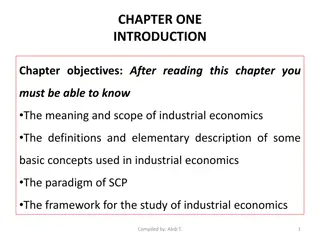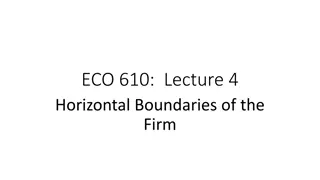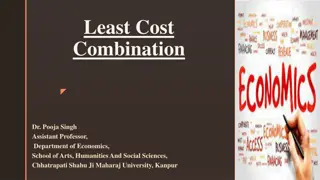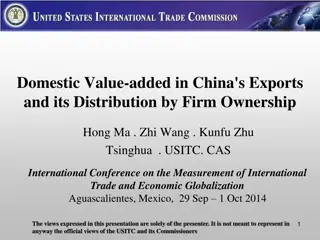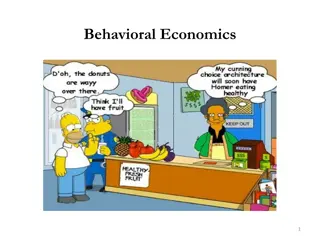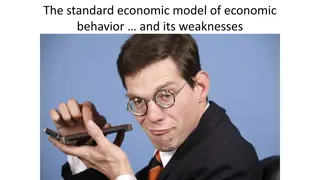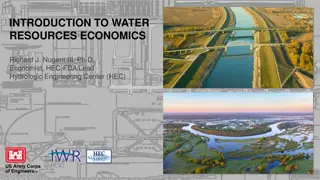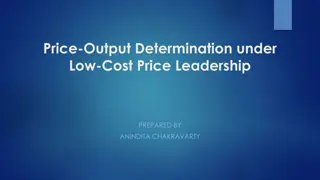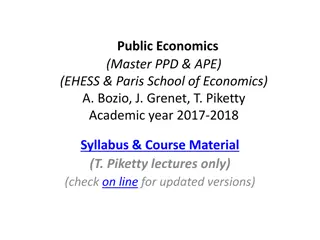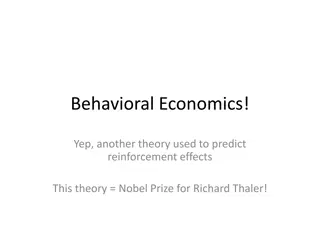Understanding Firm Behavior in Economics
Explore the theory of firm behavior in economics, focusing on the model of a firm's inputs to produce an output, the concept of specialization and diminishing returns, analysis of average and marginal product, graphical representation, and considerations in determining where a firm produces. Learn about profit maximization, fixed and variable costs, gains to specialization, and the signaling problem of profits in economics.
Download Presentation

Please find below an Image/Link to download the presentation.
The content on the website is provided AS IS for your information and personal use only. It may not be sold, licensed, or shared on other websites without obtaining consent from the author. Download presentation by click this link. If you encounter any issues during the download, it is possible that the publisher has removed the file from their server.
E N D
Presentation Transcript
Model of Firm Model of Firm 2 inputs Labor and Capital to Produce an output Q = F(K, L) Could add other inputs, but amount used varies with K,L In short-turn, K fixed Firm decides how much labor to use
Observe two regions for a typical firm Change in Q/Change in L rising (specialization) Example Change in Q/Change in L falling (diminishing returns) Third region - Q as L can be justified theoretically, but not practically
Example. Example . Labor ------- Output ---------- 0 10 25 50 65 70 70 0 1 2 3 4 5 6
Calculate Average Product, Marginal Product for each Level of Output Labor Output ------- ---------- 0 1 2 3 4 5 6 AP (Q/L) ----------- ----- 10 12.5 16.7 16.2 14 11.7 MP ( Q/ L) 0 10 25 50 65 70 70 10 15 25 15 5 0
Graphically Graphically
Where Firm Produces Where Firm Produces Region 1 Gains to specialization, must exhaust these Region 3 Marginal Product is <0, Add labor, get reduced output Therefor, must operate in Region 2 If wages are high and prices are low, MP must be high, and firm operates at beginning of Region 2 If wages are low, and prices are high, can operate at end of Region 2
Brief Introduction to Behavior of the Firm Brief Introduction to Behavior of the Firm Assumptions Firms profit-maximize This is what empirical data supports Firm faces two kinds of costs, fixed and variable Fixed costs are sunk costs, and are irrelevant to the choice of where to produce Firms face both gains to specialization and diminishing returns
Additionally. Additionally . Economists address signaling problem of profits by dividing up costs into explicit and implicit costs No way of knowing if a certain level of profitability if good unless you compare it to something else Profits of firm in economics = Revenue Explicit Costs Implicit Costs Implicit Costs are what would be made in the next best industry If > 0, firm should remain where it is If < 0, firm should change industries
Introduction to Costs Introduction to Costs Separate out fixed and variable costs Those that don t vary with output and those that rise with output Once again, for simplicity, use labor as the sole variable input
Example (Let the cost of labor = $100/unit) Labor Quantity Variable Costs Fixed Costs Total Costs 0 0 1 5 2 15 3 30 4 50 5 65 6 75 7 80 8 80 0 200 200 200 200 200 200 200 200 200 200 300 400 500 600 700 800 900 1000 100 200 300 400 500 600 700 800
Redefine Curves as Averages and Redefine Curves as Averages and Marginals Marginals AFC = FC/Q AVC = VC/Q ATC = TC/Q MC = TC/ Q = VC/ Q
Example (Let the cost of labor = $100/unit) Quantity VC 0 5 15 30 50 65 75 80 80 FC 200 200 200 200 200 200 200 200 200 TC 200 300 400 500 600 8 700 800 900 1000 AVC ----- 20 13.3 10 ATC ----- 60 26.7 16.7 12 10.8 10.7 11.3 12.5 MC ----- 20 10 0 100 200 300 400 500 600 700 800 6.7 5 6.7 10 20 ----- 7.7 8 8.8 10
Profit Profit- -Maximization Maximization Let P =$20 Let P =$20 Quantity VC 0 5 15 30 50 65 75 80 80 FC 200 200 200 200 200 200 200 200 200 TC 200 300 400 500 600 700 800 900 1000 Revenue Profit (TR-TC) -200 -200 -100 +100 +400 +600 +700 +700 +600 0 0 100 200 300 400 500 600 700 800 100 300 600 1000 1300 1500 1600 1600
Market Structures Perfect Competition Monopoly Monopolistic Competition Oligopoly
Assumptions Underlying Perfect Competition Assumptions Underlying Perfect Competition Homogeneous product Free entry and exit Many producers No one producers is a substantial part of the market
Market v. Firm Price determined at intersection of supply and demand Individual firm then takes as given Price set by interaction of thousands of demanders and thousands of producers Firm cannot influence
Price and Marginal Revenue ( Price and Marginal Revenue ( TR/ TR/ Q) Q) Price $10 $10 $10 $10 Quantity 10 20 30 40 Revenue $100 $200 $300 $400 Marginal Revenue 100/10 = 10 100/10 = 10 100/10 = 10 100/10 = 10
Conclude: MR = P Profit-maximization at MR = MC Therefor, at P = MC
Three Possible Outcomes Three Possible Outcomes P>ATC -> profits P<ATC -> losses P = ATC -> zero profits (LT equilibrium)
Five Critical Points P > ATC -> profits P = ATC -> zero economics profits AVC < P < ATC -> firm loses money, but stays open in the SR P = AVC -> indifference point P < AVC -> Shut-down
Long Long- -Run Adjustment Run Adjustment Free entry and exit
Positives and Negatives of Perfect Competition Positives and Negatives of Perfect Competition Market highly efficient Produce at P = MC (social efficiency) in both short- and long-run Produce at technical efficiency in LR (minimum ATC) Negative Does not promote innovation Highly competitive environment does not produce resources necessary for innovation
Market Structure #2 Market Structure #2- - Monopoly Monopoly Market Characteristics Single firm Strong barriers to entry No close substitutes Firm and market are the same
Demand and Marginal Revenue Demand and Marginal Revenue Price 50 40 35 30 25 20 15 Quantity Revenue Marginal Revenue 0 0 10 400 20 700 30 900 40 1000 50 1000 60 900 40 30 20 10 0 -10
Causes of Monopoly Causes of Monopoly Legal Post Office Patent Monopolies Economies of Scale Microsoft, Google (not a true monopoly) Natural Monopolies Geographic monopolies Joe s Last Chance Garage
Antitrust Antitrust Federal law seeks to prevent monopoly through antitrust actions Federal Trade Commission +Justice Department if illegal (collusion) Alternative is to allow monopoly and then regulate Antitrust also addresses cartels, which are pseudo- monopolies Firms that band together and set prices and quantities
Problems with Monopoly Problems with Monopoly Firm under-produces Consumers face lower Q and higher P
Lose both technical and allocative efficiency And, these two desirable points are at different Qs Impossible for firm to produce at both points Can regulate to one of two points if natural monopoly Balanced by tendency of monopoly firms to innovate
Short Short- -Run Equilibrium Run Equilibrium Profits can occur in short-run Due to product differentiation In long-run, since barriers to entry are weak, profits will be eliminated
Short Short- -Run Monopolistic Competition Run Monopolistic Competition
Key Things to Note. Zero profits in long-run (similar to perfect competition) Not at minimum ATC or P = MC Do not achieve either form of efficiency Trade-off -> Consumers willing to pay extra for differentiated products
Oligopoly Oligopoly Market dominated by 3 or 4 large firms Measured by concentration ratio or Herfindahl Index Strong barriers to entry Product can either be differentiated or homogeneous (pure oligopoly) Automobiles v. Steel Price interdependency Price leadership
Game Theory Video https://www.bing.com/videos/search?q=youtube+beautiful+mind+ba r+scene&view=detail&mid=F3E04B2319DE14334FE1F3E04B2319DE1 4334FE1&FORM=VIRE
Profits in 2 Firm Game High Price (Firm 1) $100m (I)/$50m (2) $150m(1)/$30m (2) $50m (I)/$80m (2) Low Price (Firm 1) High Price (Firm 2) Low Price (Firm 2) $70m(I)/$40m (2)
Alternative Alternative Graphical Model Graphical Model 2 Demand Curves Proportional and Perceived Assumptions behind each Results in Kink in demand curve
Firm must operate at kink, or the entire model collapses and we start over If costs are continuously rising, eventually the whole industry will raise its prices in tandem Results in idea of price leader firm that is responsible for all price changes Usually biggest firm
Cartels Cartels Group of firms that band together to set prices Illegal in U.S. common in world markets Petroleum, sugar, tin, bauxite, coffee, cocoa and natural rubber DeBeers Also common in Europe due to differences in antitrust enforcement
Goal of Cartel is to Maximize Joint Profits Note can no longer set MC = MR Cartelized industries are NOT markets, they are anti- markets Behave more like a monopolist that can ignore its demand curve
Conditions for Cartelization Conditions for Cartelization Product must be relatively homogeneous Few Producers Barriers to Entry No Close Substitutes Nonperishable
Graphically Graphically




